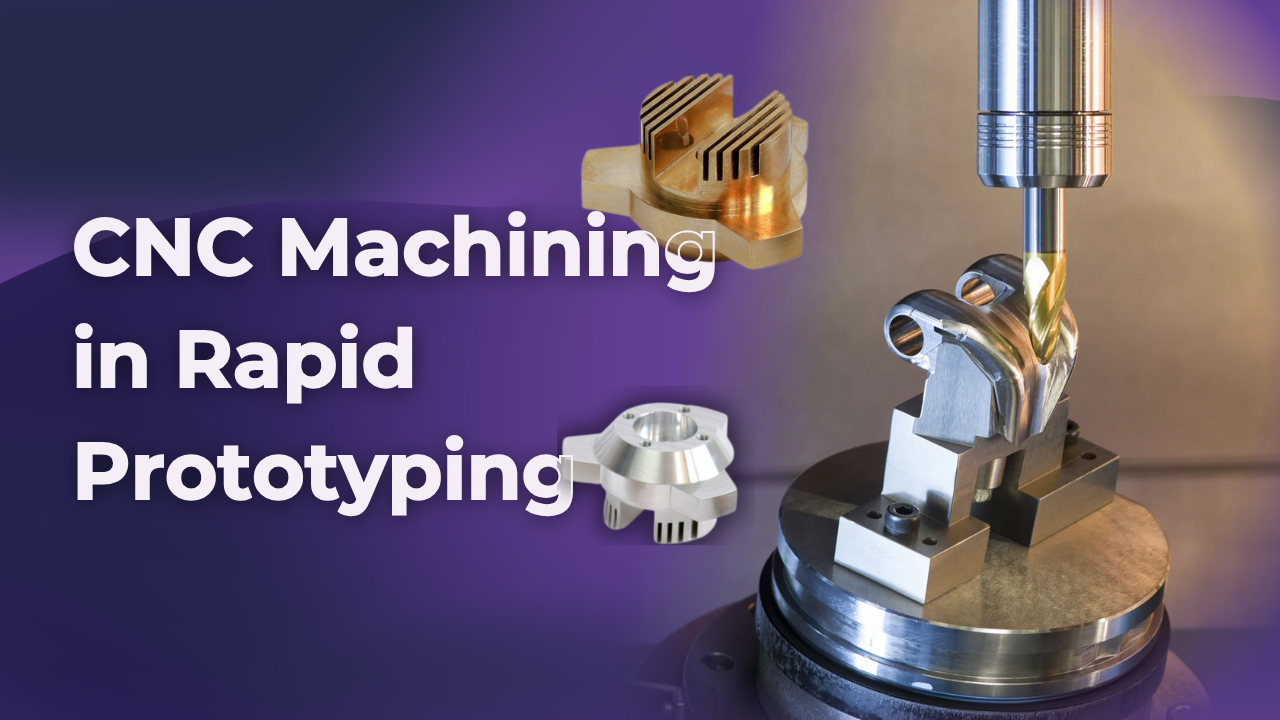Developing a successful product requires speed, precision, and flexibility. Engineers often face tight deadlines, complex designs, and the pressure to deliver accurate prototypes. Critical flaws may go unnoticed without reliable prototypes, leading to costly delays and design failures.
CNC machining in rapid prototyping offers a powerful solution combining precision, material versatility, and fast turnaround times. With modern CNC systems, businesses can create complex parts with tight tolerances while accelerating design validation. By choosing CNC machining in rapid prototyping, teams can minimize rework, reduce costs, and bring products to market faster — all without compromising quality.
Why CNC Machining is Ideal for Rapid Prototyping?
Many businesses struggle to find a manufacturing method that balances speed, accuracy, and cost when developing prototypes. CNC machining is an ideal solution due to its technical capabilities, which address key challenges in rapid prototyping.
High-Fidelity Prototyping for Complex Designs
Creating prototypes with intricate features like sharp corners, thin walls, and deep cavities often leads to tool deflection, uneven surfaces, or dimensional errors. CNC machining ensures precise replication of complex designs. Advanced 5-axis CNC systems enable multi-directional cutting, reducing the need for multiple setups and minimizing positioning errors. This ensures prototypes maintain dimensional accuracy even with complex geometries.
Specialized tools like ball-nose cutters and corner radius tools improve detail quality, while optimized toolpaths reduce surface imperfections. CNC machining in rapid prototyping is ideal for producing parts with challenging features and fine details.

Material Integrity and Performance Testing
Prototypes often require materials that match the mechanical properties of final production parts. Poor machining practices can weaken material strength, impact heat resistance, or cause surface defects.
CNC machining maintains material integrity through controlled cutting strategies. It supports a variety of materials like 7075 aluminum, 304 stainless steel, and PEEK, ensuring prototypes meet strength, durability, or heat resistance requirements.
CNC machines use variable spindle speed control to optimize cutting speeds for different materials to prevent material distortion. High-pressure coolant systems reduce thermal buildup for heat-sensitive materials like titanium, ensuring stable material properties throughout machining.
Precision-Driven Tolerance Control
Achieving precise dimensions is critical in prototyping to ensure components fit correctly and function as intended. Even slight deviations can lead to assembly issues or performance failures.
CNC machining in rapid prototyping achieves tolerances as tight as ±0.01 mm. Integrated in-machine probing systems measure critical dimensions directly during machining, allowing for real-time adjustments. This minimizes post-processing corrections and ensures consistent accuracy across multiple prototypes.
Adaptive Machining for Design Iterations
Design changes are common during prototyping, often resulting in costly delays or wasted materials. CNC machining in rapid prototyping offers flexible solutions for fast design updates. With advanced CAD-CAM integration, design modifications are quickly converted into updated toolpaths, reducing programming time.
Parametric programming allows engineers to adjust dimensions, hole placements, or part features without rewriting the entire CNC program. Modular tooling systems further speed up adjustments by minimizing setup changes. This adaptability ensures fast, accurate production even during frequent design revisions.

Functional Prototypes for System Integration
Prototypes designed for mechanical testing, thermal analysis, or performance evaluation must match the strength and functionality of production parts. CNC machining produces robust, test-ready prototypes. Techniques like hard milling, thread milling, and diamond turning improve part strength and wear resistance.
For added durability, CNC-machined prototypes can undergo surface treatments like anodizing, nickel plating, or Teflon coating, enhancing corrosion resistance, heat tolerance, and overall performance. These treatments ensure prototypes perform reliably under real-world conditions.
Challenges of CNC Machining in Prototyping and Product Development
Prototyping projects often face technical challenges that impact precision, speed, and cost. Frigate’s CNC machining solutions address these issues with advanced strategies to improve accuracy, efficiency, and cost control.
Precision Control in Multi-Material Machining
Machining hybrid designs that combine materials like aluminum, copper, or brass can cause vibration, uneven cuts, and tool wear due to differences in hardness and cutting resistance.
Frigate overcomes this with variable spindle speed control, adjusting cutting speeds dynamically for different materials. For example, spindle speeds may shift between 2,500 RPM for copper and 6,000 RPM for aluminum to maintain cutting stability.
Dynamic feed rate adjustments improve control by modifying cutting speeds based on material properties. Frigate’s rigid fixturing systems also minimize material movement, ensuring tolerances as tight as ±0.01 mm in complex hybrid parts.
Geometric Complexity in Prototype Designs
Prototypes with thin walls, deep cavities, or asymmetric features are prone to tool breakage, chatter marks, and dimensional errors.
Frigate’s 5-axis synchronized CNC machining creates complex geometries in a single setup, reducing setup errors by up to 30%. Additionally, collision detection software simulates tool movement before machining starts, preventing tool interference and minimizing errors.
For delicate structures, Frigate applies trochoidal milling, a technique that reduces cutting pressure, prevents wall deformation, and improves surface quality.
Rapid Iteration Without Compromising Accuracy
Frequent design changes can introduce dimensional errors, leading to rework and delays.
Frigate’s closed-loop machining system uses feedback sensors to track dimensional shifts in real time, detecting deviations as small as 5 microns. Combined with automated tool offset correction, this system ensures stable dimensions across multiple design updates.
Frigate’s digital twin simulations further improve accuracy by predicting CNC machining in rapid prototyping issues before production starts, reducing rework rates by up to 40%.
Achieving Surface Uniformity in Prototypes
Inconsistent surface finishes can affect aesthetics, sealing points, or coating adhesion.
Frigate’s precision finishing processes ensure uniform textures across complex parts. Micro-milling achieves finishes as smooth as Ra 0.4 µm, while abrasive polishing removes micro-burrs and tool marks.
Frigate’s vapor honing process creates smooth, consistent surfaces for matte or non-reflective finishes. Quality is verified using laser profilometers that measure surface roughness with an accuracy of ±0.02 µm.
Prototype Cost Optimization
Frequent design changes lead to material waste, longer machining hours, and higher costs.
Frigate reduces costs using digital twin simulations, which predict machining outcomes to minimize trial-and-error. This reduces scrap rates by up to 35%.
Frigate’s automated quoting system optimizes toolpaths to shorten CNC machining in rapid prototyping cycles and reduce tool wear. For high-volume prototypes, nesting strategies maximize material usage, lowering raw material costs and machining time.
Applications of Rapid Prototyping with CNC Machining
CNC machining in rapid prototyping is crucial in developing precision-driven prototypes across industries where accuracy, durability, and fast design cycles are critical. Frigate’s CNC machining solutions address complex challenges with tailored techniques to deliver reliable, high-performance prototypes.
Aerospace Innovation
To meet strict performance standards, aerospace prototypes demand precise geometries, lightweight structures, and high-strength materials.
Client Challenge
An aerospace manufacturer faced difficulties machining a high-thrust turbine blade with airfoil profiles requiring ±0.01 mm tolerances. Conventional methods resulted in dimensional inconsistencies, reducing aerodynamic efficiency.
Frigate Solution
Frigate utilized 5-axis CNC milling to create uniform airfoil geometries in a single setup, reducing positional errors by 30%. For improved heat resistance, the blade was machined from Inconel 718, a superalloy with a melting point exceeding 1,350°C. Frigate’s dynamic spindle speed adjustments minimized tool wear, ensuring precise contouring across the turbine blade’s complex profile.
Medical Device Advancements
Medical prototypes require biocompatible materials, flawless finishes, and precise tolerances to meet FDA and ISO 13485 requirements.
Client Challenge
A medical device company developing spinal implants needed titanium prototypes with intricate bone-growth surfaces. Conventional CNC machining in rapid prototyping methods struggled to achieve the required surface texture for optimal osseointegration.
Frigate Solution
Frigate employed micro-milling with end mills as small as 0.2 mm, producing uniform textures that improved osseointegration by 25%. The parts underwent abrasive polishing to ensure optimal cleanliness, achieving a surface finish of Ra 0.4 µm, minimizing bacterial risks, and ensuring safe medical application.
Automotive Component Development
Automotive prototypes must balance strength, lightweight design, and dimensional accuracy to meet performance standards.
Client Challenge
An EV manufacturer developing battery enclosures required lightweight aluminum prototypes with ±0.01 mm tolerances and thin walls measuring 1.5 mm. Previous machining attempts resulted in warping and dimensional instability.
Frigate Solution
Frigate leveraged 5-axis CNC milling with adaptive feed rates to improve machining stability in thin-wall sections. Frigate applied hard milling techniques to reinforce critical mounting points for added durability. The optimized CNC machining in rapid prototyping strategy improved dimensional stability by 40%, ensuring seamless battery cell integration.
Electronics and Semiconductor Innovation
Prototypes for electronics demand precise geometries for thermal control, shielding, and electrical performance.
Client Challenge
A semiconductor manufacturer developing server cooling systems required copper heat sink prototypes with micro-fins measuring 0.3 mm thick. Previous attempts failed to maintain uniform spacing, reducing cooling efficiency.
Frigate Solution
Frigate applied high-speed CNC milling with precision toolpath control to achieve ±0.005 mm tolerances. Frigate optimized the fin geometry to improve thermal performance using trochoidal milling, ensuring uniform spacing and improved airflow efficiency. The result was a 20% improvement in heat dissipation during testing.

Renewable Energy Sector
Renewable energy components require strong, corrosion-resistant prototypes that withstand mechanical stress and environmental exposure.
Client Challenge
A wind turbine manufacturer required planetary gear prototypes with precise tooth profiles to ensure smooth power transmission. Conventional CNC machining in rapid prototyping resulted in profile deviations exceeding acceptable limits, affecting gear efficiency.
Frigate Solution
Frigate combined gear hobbing with contour milling to achieve profile deviations below ±0.02 mm. Frigate’s CNC systems applied variable spindle speeds to control cutting pressure, ensuring accurate gear geometry with minimal distortion. This improved gear performance, reducing noise levels by 15% and enhancing torque transmission.
Conclusion
CNC machining in rapid prototyping is vital in delivering accurate, functional prototypes that support faster product development. Frigate’s CNC solutions provide unmatched precision, faster design iterations, and improved material performance — all while minimizing costs.
Frigate’s online CNC machining platform allows you to upload CAD files, get an instant quote, and receive parts in 7 days.
Contact Frigate today to experience faster, more reliable CNC machining solutions that accelerate your product development journey.


